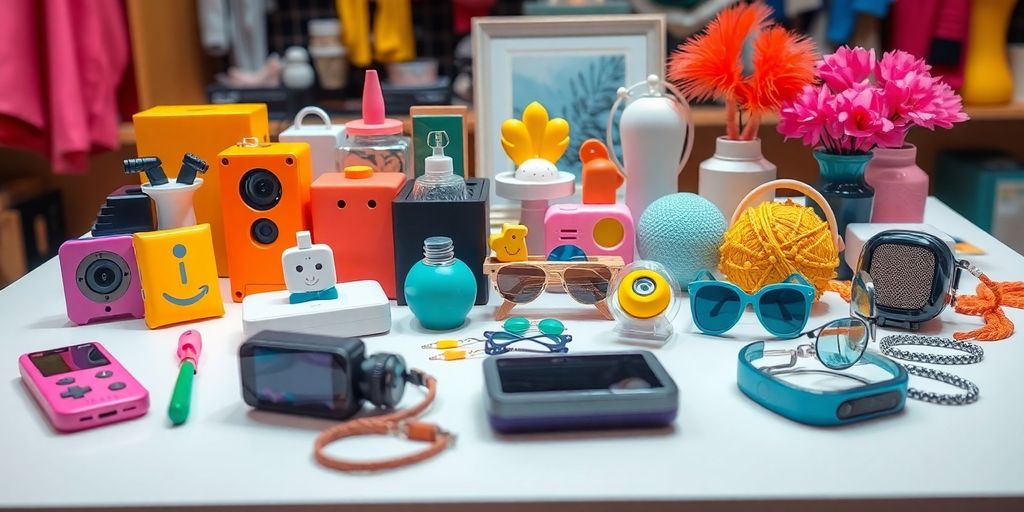In today’s fast-paced world, coming up with product ideas that can capture consumer interest is crucial for any business. This article will explore various innovative product ideas, focusing on emerging trends, technology integration, and sustainability. By understanding consumer needs and utilizing market research, you can craft compelling product ideas that stand out in the modern market.
Key Takeaways
- Stay updated on emerging trends to find fresh product ideas.
- Use technology to create unique and innovative products.
- Focus on sustainability to appeal to eco-conscious consumers.
- Gather feedback from customers to improve product development.
- Conduct market research to identify gaps and opportunities.
Innovative Product Ideas for the Modern Market
Exploring Emerging Trends
Alright, let’s dive into some cool stuff happening in the product world. Trends are like waves, and if you catch them at the right time, you’re in for a ride. Emerging trends can be your best friend when thinking about new products. Think about things like smart home gadgets or health and wellness products. People are all about convenience and looking after themselves these days. So, if you can tap into that, you’ve got a winner.
Leveraging Technology for Unique Products
Tech is everywhere, right? It’s in our pockets, on our wrists, even in our fridges. Using tech in your products isn’t just smart; it’s necessary. Imagine creating something that syncs with other devices or helps people in their daily lives. Like, IoT devices are a big deal now. They’re the future, and if you can make something that fits into that space, you’re golden.
Sustainability as a Selling Point
People care about the planet, and that’s a good thing. Products that help the environment or are made sustainably are getting a lot of love. So, if you can come up with ideas that are eco-friendly, you’re not just doing good; you’re also likely to sell more. It’s like hitting two birds with one stone, but, you know, without hurting any birds.
Crafting Product Ideas That Capture Consumer Interest

Understanding Consumer Needs
So, you want to make stuff people actually want to buy? Understanding what folks need is where you start. Think about it: if you know what people are itching for, you’re halfway there. Here’s how you can dig into this:
- Talk to People: Seriously, just ask around. Friends, family, or even random folks online. Get their thoughts on what’s missing in their lives.
- Check Out Reviews: Look at reviews of products similar to what you’re thinking of making. Folks are pretty vocal about what they love and what they hate.
- Follow Trends: Keep an eye on what’s trending. Sometimes a small trend can blow up into a huge demand.
Incorporating Feedback into Product Development
You got a product idea? Cool. But don’t just stop there. Feedback is your best friend. Here’s how to make the most of it:
- Prototype First: Before going all in, make a prototype. It doesn’t have to be perfect, just something to show around.
- Gather Opinions: Show your prototype to a bunch of people. Listen to what they say, even if it’s not what you want to hear.
- Iterate: Take the feedback and tweak your product. It’s all about making it better step by step.
Creating a Unique Value Proposition
Now, let’s talk about standing out. Your product needs a little "something" that makes it special. Here’s how to figure that out:
- Identify Your Edge: What makes your product different? Maybe it’s the price, the quality, or something quirky.
- Communicate Clearly: Make sure people know why your product is the best choice. Keep it simple and clear.
- Test Your Pitch: Try out your value proposition on a few people. If they get excited, you’re on the right track.
"It’s not just about having a great idea; it’s about making sure everyone else thinks it’s great too."
Crafting product ideas isn’t just about the idea itself. It’s about knowing your crowd, listening to them, and making sure your product stands out in a crowded market. Good luck out there!
Utilizing Market Research to Generate Product Ideas

Analyzing Competitor Success
Alright, so first up, checking out what your competitors are doing can be a goldmine. If someone else is doing well, there’s a reason. Look at what they’re selling, how they’re selling it, and who they’re selling it to. Make a list. You might find a gap they missed or a way to do it better.
Identifying Gaps in the Market
Next, let’s talk about finding gaps. This is about spotting areas where no one is really hitting the mark. Maybe there’s a product people want but can’t get, or something that could be improved. Think about what’s missing in your daily life or ask around. List down these ideas.
Using Data to Predict Trends
Finally, get into the data. Numbers don’t lie. Check out market reports, surveys, and any available data to see where things are heading. Are more folks going green? Is tech the next big thing? Use this info to predict what might be the next hot product.
Market research isn’t just about numbers and stats. It’s about understanding what people want and figuring out how you can provide it. By analyzing competitors, spotting market gaps, and using data, you can come up with product ideas that really sell.
The Role of Technology in Developing Product Ideas
Integrating IoT in Product Design
So, IoT is, like, everywhere now. Everything’s getting "smart," from fridges to light bulbs. If you’re thinking of product ideas, consider how IoT can make ’em better. Like, imagine a coffee maker that starts brewing when your alarm goes off. That’s the kind of thing people are into these days. Smart stuff just sells.
Utilizing AI for Product Innovation
AI isn’t just for sci-fi movies anymore. It’s helping create new products by predicting what people want. Think about AI that suggests the perfect outfit based on the weather and your calendar. That’s not just cool—it’s useful. AI can help you come up with ideas that really click with folks.
Enhancing User Experience with Technology
Nowadays, tech can make using products way more fun and easy. Like, take voice assistants. They let you change the TV channel without lifting a finger. Or apps that let you design your own shoes. Tech can turn a regular product into something people can’t live without. It’s all about making life simpler and more enjoyable.
Sustainable Product Ideas for Eco-Conscious Consumers
Materials and Design for Sustainability
When it comes to sustainable products, the materials and design matter a lot. Here are some ideas:
- Biodegradable materials: Products made from materials that break down naturally, like biodegradable cutlery.
- Bamboo products: Items like bamboo toothbrushes and picnicware are gaining popularity.
- Recycled materials: Using recycled plastics or metals can reduce waste.
Marketing Eco-Friendly Products
Getting the word out about your sustainable products can be a challenge. Here are some tips:
- Highlight environmental benefits: Make sure consumers know how your product helps the planet.
- Use eco-friendly packaging: Show your commitment to sustainability from the start.
- Leverage social media: Share your story and engage with eco-conscious consumers online.
Case Studies of Successful Sustainable Products
Looking at what works can inspire new ideas. Here are a few examples:
- Reusable water bottles: The market for these has exploded as consumers want to cut down on single-use plastics.
- Eco-friendly cleaning products: Brands that focus on natural ingredients have found a loyal customer base.
- Sustainable fashion: Companies that use organic materials and ethical labor practices are thriving.
Creating sustainable products is not just good for the planet; it can also be a smart business move. Consumers are increasingly looking for eco-friendly options, so tapping into this market can lead to success.
Turning Product Ideas into Profitable Ventures
Alright, so you’ve got this awesome product idea, but how do you know if it’ll actually work? That’s where prototyping comes in. Making a prototype lets you see your idea in real life and figure out any kinks. It’s like a test run before you go all in. Start with something simple, maybe even a basic model, just to see how things fit together. Then, test it out. Get feedback from friends, family, or even strangers. What do they like? What doesn’t work? Use this info to tweak and improve. It’s all about trial and error until you get it just right.
Building a Brand Around Your Product
Now, let’s talk branding. Your product’s cool, but how do people know it’s yours? This is where branding steps in. You want a name, a look, and a vibe that screams "this is us!" Think about colors, a logo, maybe even a catchy slogan. It’s like giving your product a personality. Once you’ve got that down, make sure everything you do matches that brand. From packaging to social media posts, keep it consistent. People remember stuff that stands out, so make sure your brand is memorable.
Strategies for Launching and Scaling
Launching your product is a big deal. It’s like opening night for a play. You want everything to go smoothly. Start by having a plan. Know who you’re selling to and where you’ll sell it. Maybe start small, like online or at local markets, then grow from there. Scaling up means getting bigger without losing what makes your product special. Keep an eye on quality and customer feedback. As you grow, adjust your strategies to meet demand. It’s all about being flexible and ready to adapt to whatever comes your way.
Exploring Niche Markets for Unique Product Ideas
Identifying Untapped Niches
Finding a niche is like discovering a hidden gem in a crowded market. It’s not about what’s trending but about what’s missing. Look for areas where demand is unmet or underserved. You know, those little pockets of opportunity where you can introduce something fresh and exciting. It might be a product that solves a unique problem or caters to a specific group of people. Think about hobbies, interests, or even problems that don’t have a lot of solutions yet.
Tailoring Products to Specific Audiences
Once you’ve found your niche, it’s all about making sure your product fits like a glove for your audience. Get to know them. What do they like? What do they need? Create a product that speaks directly to them. Here’s a simple checklist to keep in mind:
- Research your audience’s preferences
- Design products that align with their lifestyle
- Focus on quality and uniqueness
Success Stories from Niche Markets
There are tons of examples where businesses have hit it big by focusing on niche markets. Take the craft beer industry, for instance. It blew up because people wanted something different from the usual big-brand beers. Or look at the rise of eco-friendly products; businesses tapped into a growing demand for sustainable living. These success stories show that with the right idea and execution, niche markets can be incredibly rewarding.
Sometimes, the best ideas come from simply listening to what people are missing in their lives and finding a way to fill that gap.
Final Thoughts on Product Ideas That Sell
In conclusion, finding the right product to sell can be a fun and exciting journey. By exploring different ideas and understanding what customers want, you can discover products that not only sell well but also make a difference. Remember to think about your interests and how you can improve existing products. Keep an eye on trends and listen to what people are saying about their needs. With creativity and a little research, you can find the perfect product that will attract buyers and help your business grow.
Frequently Asked Questions
What are some new product ideas that are popular right now?
Some popular product ideas include eco-friendly items, smart home gadgets, and personalized accessories. These products are trending due to growing consumer interest in sustainability and technology.
How can I find out what products people want to buy?
You can learn what products people want by doing surveys, checking social media trends, and looking at what competitors are selling successfully.
Why is sustainability important in product development?
Sustainability is important because many consumers prefer to buy products that are good for the environment. Using eco-friendly materials can also help your brand stand out.
What steps should I take to launch a new product?
To launch a new product, start by researching your market, creating a prototype, testing it with potential customers, and then planning your marketing strategy.
How can technology help in creating new products?
Technology can help by providing tools for design, manufacturing, and marketing. For example, using software can streamline the design process and help you reach customers online.
What are niche markets and why should I consider them?
Niche markets are specific segments of the market with unique needs. Focusing on a niche can help you target your products better and face less competition.







